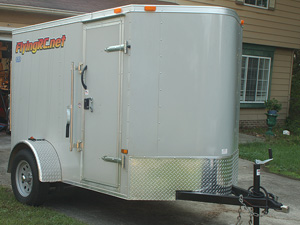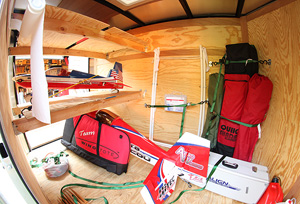


Text, photos and video by Tom Hintz
Posted – 10-1-2014

A large percentage of radio control aircraft fanatics (yes, we are fanatics) have an irresistible yearning for more and often larger model aircraft. I repeatedly vowed to stay in the “40 size” aircraft that could be transported in todays’ cars and easier to fund for those of us that recognize the word budget. Despite all this I found myself with that yearning for bigger models.
I had noticed the growing number trailers carrying aircraft to our flying field and the idea of my owning one began making lots of sense to me. Part of my flying day was devoted to carefully packing everything I took to the field into a KIA Soul. I refined the packing sequence to where I could get my 12V car battery and cart, an old Align 450 aluminum case repurposed for my “crash parts and supplies”, my PVC plane stand, brief case converted to carry my charging gear, aluminum two radio case, my pit box, a 60” Extreme Flight Edge 540T-EXP, a Pilot 26% YAK 54 (73”-wing) and two wing bags. When I was going to shoot video for reviews a tripod and a couple cameras had to be snuck in there someplace. Packing was occasionally complicated by having to keep the passenger front seat clear when my wife came with or drove me to the field. If we wanted to go to a flying event somewhere in our car my pop up canopy and chairs might have to drag behind the car on the rope.
A trailer was making lots of sense the more I thought about it. I discovered another issue in that KIA apparently has no faith in the Soul pulling any trailer (oddly in the US only) so as the trailer search got underway we traded the Soul for a KIA Sportage that actually had a tow rating.
As I checked out aircraft trailers I noticed that most were larger than the 5 by 8-foot models I was considering. The fact that all of those were pulled by pickups and full sized SUV’s did not escape me. I also noted that I would have to spend a ton of money to fill up a larger trailer so I stuck with 5 by 8-foot models.
It did not take long to see that there were two distinct levels of quality in 5 by 8-foot cargo trailers with price tags in the $2000 to $2500 range. I had one fellow show me a 5 by 8-foot trailer that he would part with for about $1900 but the top was made from multiple sheets of what looked like galvanized tin that were glued together in full width seams. As if to insure the glue seam would fail this top was just laying on some cross rails and had a good inch of up and down movement that promised to work that glue joint as hard as possible while we trucked down the highway. The interiors of the cheaper models also sucked about as much as the sectional tops. I had looked at a Continental Cargo Trailer earlier that had these “bargain” trailers beat on all counts so returned to the Continental Cargo Trailer dealer and made the deal.

The subject of this review is my shiny new 2015 Continental Cargo Trailer (Model #NS858SA) with a 5’-wide by 8’-long body. However, this body has a roughly 1-1/2’ V-nose extension to help aerodynamics and that adds usable space inside.
The Continental Cargo Trailer has a single axle equipped with 15” radial tires, shiny aluminum diamond plate across the front as a stone guard and the same material used for the fenders. They say that this trailer weighs 1100-lbs and has a gross vehicle weight rated at 2990-lbs which means as long as I am hauling balsa airplanes getting anywhere near the max weight is going to be impossible. That is a good thing for my Sportage as well.
The Continental Cargo Trailer has a ramp type rear door and a side door. Both are held closed by heavy-duty lever locks like those found on semi-trailers. The interior is nicely done in good looking plywood on the floor and walls. The floor is ¾”-this and the walls 3/8”-thick. All of the wood is secured with screws to steel ribs placed on 24” centers for the floor and 16”-centers in the walls. These screws also serve as a road map to show you where to attach things like cargo rings and other devices needed to secure everything for transport. The ceiling of the Continental Cargo Trailer comes with a crank-open vent installed for ventilation. It also has a light (12V) inside that I never use but it looks cool I guess.
I installed two shelves across the rear of the trailer. The floor is for the Aeroworks 60cc Freestyle Extra 260 QB-L and my 30cc Aeroworks Freestyle 260 Extra. The first shelf up is normally used for my electric Extreme Flight Edge 540T-EXP and the top shelf holds at least two wing bags. I have yet to design and build the front of the trailer to better handle the things I take to the field because I have been going to the field every chance I get. I hope to do more work to refine the interior of the Continental Cargo Trailer this winter.
Despite my putting off working on the interior to better use the space I am able to get all of my planes and support equipment in the trailer easily. I also carry around my pop up tent and chairs that are normally used at fun fly’s.

Even when fully loaded (mostly balsa wood) the Continental Cargo Trailer tows easily and surprisingly smooth. It will never get to when you can’t feel it behind the car but it is close. Our Sportage has a 4 cylinder engine that handles the Continental Cargo Trailer without strain. Engine temperature has stayed where it always has been even towing in the Carolina 90-plus days. Fuel mileage obviously declines when towing the trailer but that increase in cost has not risen enough to be an issue. I am actually towing the trailer a small percentage of the time the car is used so whatever the mileage hit is the impact on the budget is not a back breaker.
What is very nice is being able to take everything I might need to the field. I don’t know how many times since I started bring the trailer to our flying field that I have had something in the crash box that other flyers or myself needed to get a plane back in the air. In the pre trailer days that crash box often had to stay home if I took another plane.
It is also nice to be able to bring three or four planes even if I intend to fly just one or two. As can happen a small issue with one plane can end your day early. Now I can just go to the trailer and pull out another one to fly the rest of the day.
When I carried everything in the car hangar rash was an obvious problem because fuselages had to cross one another to get everything in. That made dents and covering tears way to common. Plus in the car only days I lived in fear of having to hit the brakes or take evasive action to miss another car and hear the pit box or charging battery go through a fuse or two. In that regard the Continental Cargo Trailer is saving me significant dollars.
Another nice thing about the trailer is that I can carry gasoline-powered models and gas cans that simply cannot be in a car. Another important thing is the fact that the Continental Cargo Trailer is weather proof and you can leave everything in it for a while when rain chases you home from the flying field.
Certainly a trailer is a luxury to some extent but its protective qualities offset some of that cost in repair savings. The Continental Cargo Trailer cost me right at $2300.00 with the receiver hitch(7-20-2014) but it is a long term investment that has had a huge positive impact on my ability to get to the field with everything I need to enjoy a full day of flying.
There are lots of RC pilots that have no interest in going to big or fuel-powered planes which might make a trailer unnecessary. For many a trailer just makes sense and the Continental Cargo Trailer might be of interest. I am very happy that I bought this trailer, I use it frequently and I enjoy being able to bring everything I need to spend a day flying.
See the product page for the Continental Cargo Trailer – Click Here
Have a comment on this review? –Email Me!